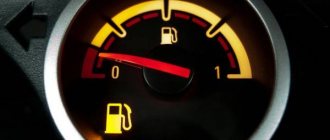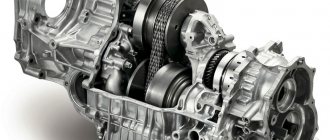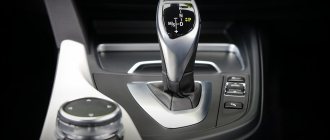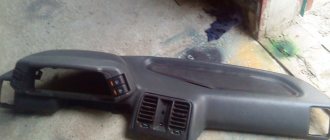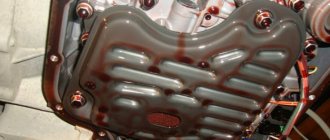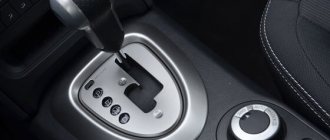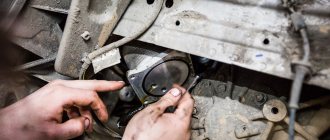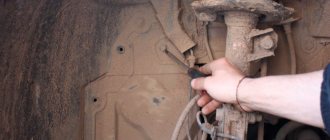CVT (CVT JATCO) is currently installed on Lada XRAY. In the future, this automatic continuously variable transmission will be installed on Lada Vesta. The CVT is structurally different from the AMT (automated transmission) and automatic transmission, therefore, when operating a car with this transmission, you should remember a number of rules that will extend the life of this transmission.
This transmission uses both a V-belt drive and a two-stage planetary gearbox with gears, as well as a torque converter. Considering this combination, AVTOVAZ calls this box: continuously variable automatic transmission, but further in the text we will use the word “variator”.
The operating instructions for the CVT are in the car manual. Here's what it says:
Overheat
There are two devices in the CVT box that generate a lot of heat. It can cause the entire gearbox to fail. So let's look at these two devices, why and under what conditions they generate increased heat.
Torque converter or clutch pack
Yes, in some CVT models there is a “donut” installed between the gearbox and the engine. It serves as a clutch. The torque converter is the first to take over the engine torque when starting off or driving at low speeds.
In continuously variable automatic transmissions, the torque converter is almost always locked . The exception is when the car is moving at low speed or standing still. At this moment the “donut” is unlocked, it begins to slip, generating a lot of heat.
Some CVT models use a clutch pack instead of a torque converter. This is also a clutch, the operating principle is different from the “donut”, but the ability to generate heat when slipping is the same. Plus, they wear out faster and emit friction dust during wear .
Box
During operation, the box itself generates heat. It is already known from the design of the variator that instead of toothed gears, a belt is responsible for shifting gears. Friction occurs between the belt and pulleys.
The smaller the diameter of any of the pulleys, the smaller the area of contact with the belt. Grip decreases and friction increases. This leads to the release of heat.
In order not to kill the variator, you need to carefully monitor the cooling system of the box. Check radiators for cleanliness and clean them if necessary.
Starting the engine
In position P
The engine can be started without pressing the brake pedal. In position N, the engine can only be started when the brake pedal is pressed. Turn on the ignition and start the engine.
Press the brake pedal and, pressing the lock button, move the gear shift lever from position P
to position
R
or
D
(depending on the desired direction to start moving). In this case, your foot should be on the brake pedal and the accelerator pedal should be released.
Huge pressure
You know that it is not recommended to tow trailers or other cars in a car with an automatic transmission. Driving through deep mud, accompanied by wheel slipping, will have a bad effect on the condition of the gearbox.
The same applies to the CVT gearbox. Only the consequences of such exploitation will be even sadder. The fact is that the variator does not have gears that are rigidly engaged with each other. Torque is transmitted through a belt mechanism.
The higher the gear ratio, the smaller the diameter of the drive pulley, the smaller the contact area of the belt with this pulley. The risk of the belt slipping along the pulley increases, which is fatal for the variator. Scores may appear on the cone plates, the belt may become damaged or break. And this is already an expensive repair of the box.
To protect the variator from rapid breakdown, you need to operate it in “gentle” conditions:
- Do not overuse towing trailers and downstream neighbors.
- When driving uphill with a load behind you, do not press the gas pedal to the floor. Smoothly pressing the pedal halfway, or better yet less, will protect the variator from slipping the belt. This applies to towing a trailer. If it’s not there, you can press down on the pedal and nothing will happen.
The main thing is that if you need to tow someone, pull a trailer, or overcome a small ford, do not press the pedal to the floor. The variator does not like heavy loads at low speeds.
Second place - oil change
And here it may seem that all recommendations for proper maintenance are similar to automatic transmissions. I don’t argue, there is some compatibility, BUT there are also differences.
I’ll start with the thesis that the oil (in general, this is a special liquid, often different from ATF ) needs to be changed - MANDATORY! On old NISSANS, the replacement interval was generally 30,000 km, then CVTs were improved (or supposedly improved), and now they need to be changed after 60,000 km. Now they can install various oil aging sensors , you can rely on their readings. However, again there are companies that say that replacement is not required and it is designed to last a lifetime, this is not correct.
Here, as in an automatic transmission, you need to change the fluid + filter (if possible). If it is not possible to change the filter, then make the internal lubricant change intervals shorter, for example after 50,000 km (and not after 60 thousand). This way the lubricant oil will not become too contaminated and you will remove it while still light and refill it fresh.
So why is it so important to change the oil inside? YES everything is simple, there is also a valve body and solenoids, only they work differently. Often, the pressure in the system, which brings the cone together, depends on their quality of work.
If the oil is dirty (wear occurs in any case), dirt particles can clog the valve body or these solenoids. As a result, there is insufficient pressure, the cones are not brought together correctly (there is no required pressure), the belt slips - scuffing.
Pedal to the floor
This is the weakest aspect of the continuously variable transmission. The more often you drive “sneaker to floor”, the faster the variator will fall apart. With a quiet ride, in the “pensioner” style, it can last many hundreds of thousands of kilometers.
The main thing for yourself is to learn one rule: “If you feel that the car is hard right now, do not press the pedal all the way” - this will greatly extend the life of the variator.
Automakers are aware of the problem and are trying to combat it. Some models have additional gears for low gears.
In some cases, where there is no such “planetary”, when driving onto a curb from a standstill, the computer “strangles” the engine, preventing it from developing maximum torque. In this case, you will not be able to drive onto the curb if you drive up close to it and stop. No matter how you turn the engine, the electronics will not allow the car to move in order to protect the variator from damage.
Reverse
It is traditionally denoted by the symbol "R". The design of the CVT transmission is such that there is no possibility of the driven shaft moving in the reverse direction. Therefore, engineers include various additional mechanisms in this system. When the driver switches the box to reverse mode, these additional mechanisms are activated.
To avoid possible malfunctions during operation, you can move the gearbox mode selection lever to reverse only after the car has completely stopped. In various car models, to engage reverse gear, you also need to press the corresponding key. In this case, you can press it only after a complete stop. By doing this, manufacturers provide protection for the gearbox mechanism.
Jerks
A similar effect can be observed when you slip a wheel and suddenly it hits a hard surface. That is, rotating at high speed on ice, for example, it stops abruptly when it reaches the asphalt. There is a shock in the transmission. Or when towing another vehicle. You take off, the cable tightens, and you suddenly stop. The blow comes again.
In both cases, the belt may slip along the pulley. One such slip will be enough to scratch the pulley. After this, increased wear and rapid “death” of the gearbox occurs.
Unlike climbing a curb, the electronics do not protect the CVT in such situations. It simply does not have time to “strangle” the engine in order to reduce the torque on the pulley and protect the variator.
If there is an urgent need to pull someone out with a cable or drive yourself out of a snow mess, there are small tricks that will help save your continuously variable transmission.
When towing with a cable:
- Smoothly select the length of the cable so that it becomes taut.
- When it reaches its maximum length, release the gas pedal. The inertia of your car will be enough to pull someone out of the mud or carefully take off from a standstill without damaging the CVT.
If your wheels slip on ice:
No need to press the gas pedal to the floor. To make the wheels spin on ice and the car to get out of the slippery surface, just press the gas halfway. When the wheel reaches the asphalt, the box will not feel a strong impact.
Parking
In this position, the transmission driven shaft is blocked by a special pin or other element. This way, manufacturers completely exclude the possibility of self-driving cars. This mode is recommended to be used only when the car is parked for a long time. There is also protection against accidental activation - in most cars you need to press a button, press the brake, and apply the handbrake. Only then can the lever be set to the desired position. To remove the gearbox from the parking lot, you will have to perform all the steps in reverse order.
E-CVT box
This is a type of continuously variable transmission for hybrid vehicles. A logical question will arise: “Do the rules for driving a CVT apply to e-CVT boxes?” - No, they don’t.
This is a completely different gearbox, although only one letter in the name has been changed. This unit is designed for hybrid cars and has nothing in common with a simple CVT. This gearbox is considered by many to be “unkillable”; its reliability is an order of magnitude higher than that of a classic automatic transmission, not to mention CVT transmissions. But we will talk about this in detail in a separate article.
Neutral position
In this position of the selector lever, the engine is disconnected from the transmission. This mode is intended for long stops. For example, the transmission is switched to neutral in traffic jams. In addition, the engine starts in this position. This is an ordinary neutral gear, which is found in almost all types of modern gearboxes. But most manufacturers do not recommend using this mode often.
Many owners are interested in whether it is possible to drive in neutral with a CVT. Of course you can, but not for long. Repair specialists categorically do not recommend doing this - in a traffic jam it is better to drive in standard mode.
Summarize
What does the owner of a car with a CVT need to know so as not to quickly “kill” it and extend its life by many thousands of kilometers. Let us recall simple operating rules:
- We don't skid on ice or mud. If you need to slip, we dose the torque with the gas pedal.
- We try to avoid towing trailers and other vehicles. If an urgent need arises, then we use the cable correctly and do not allow the machine to stop abruptly when tensioning the cable.
- The CVT gearbox does not like full throttle driving. Steady driving will extend the life of your CVT.
- We monitor the cleanliness of the cooling system of the continuously variable transmission. She doesn't like overheating and falls off quickly.
- We change the oil in the box strictly according to the regulations and compliance with the technology of the unit manufacturer.
I ask you to supplement this article with advice on how to increase the service life or how to properly use CVTs on cars. Perhaps I missed something, I will be grateful for your additions in the comments.
First place - firmware
You know, I never attached any importance to this. However, it is important to update a MODERN variator, and it needs to be done correctly.
In general, I don’t remember now what kind of “cheese-boron” my friend had an old NISSAN QASQAI, which was about 8-10 years old. He rode the CVT for 120,000 km and did not suffer any breakdowns, he liked everything, so he sold it.
Then he had other cars, and for his wife he bought a NISSAN JUKE with CVT (from the old memory of the brand).
So there were a lot of problems with this car. Variator errors constantly appeared, and it went into emergency mode and that’s it (all this started at about 30,000 km) and continued with “periodicity”, in my memory it happened 2-3 times exactly.
They took the car to the dealer, they connected the equipment to the brain, did some magic, and gave the car back. The car drove for some time and again the same error.
“So what is the reason,” you ask? My answer (in the end we overcame this problem) is that the problem was in the firmware, it did not regulate the oil pressure correctly, due to which the “cones-shafts” were not compressed enough. The belt could slip, as a result, the electronics saw all this and an error came out.
With the third or fourth firmware, the whole thing was corrected, no more emergency situations appeared. BUT, as the master said, it’s better to go to a service station during the warranty period, if such new firmware appears, they are required to download them, and you may not even know about it.
Now let's watch the video version of the article.
This concludes my materials, I think you found it useful. Read my blog, subscribe to the YOUTUBE channel, there will be many more interesting videos. Sincerely yours, AUTOBLOGGER
Similar news
- Why do the Germans (MERCEDES and BMW) have rear-wheel drive: Details + video...
- Dual mass flywheel. What is it, how does it work? Breakdowns and r...
- How to check the oil level in a machine?
Add a comment Cancel reply
Towing
And this is also prohibited, just like skidding. For the box, both of these actions are very unsafe. You can take the car towed - the engine must be running. But even if there is no oil starvation, it is better not to risk it. The instructions on how to drive a CVT specifically state that towing is possible either with a rigid hitch or with a flexible hitch in neutral mode with the engine running. If the conditions are different, then it is better and cheaper to call a tow truck.
But don’t get carried away with towing other cars. This will lead to increased loads on the transmission system and increased, intense wear. Manufacturers and repair specialists only allow the transportation of trailers with a gross weight of up to 1 ton.
Types of variators
There are several types of CVT gearboxes:
- V-belt,
- toroidal,
- chain
Let's consider the device of the first two, which are the most popular.
V-belt variator
This is the most common type of CVT gearbox. A V-belt variator consists of two pulleys (driver and driven), connected to each other by a metal V-belt.
Each pulley consists of two cone-shaped disks with sharp ends facing each other. These cones can move towards each other and back. As the cones move relative to each other, the diameter of the pulley changes smoothly, which leads to an increase or decrease in the friction force when the belt moves and a change in the radius of the belt bending around the pulleys, and thus to a smooth change in the gear ratio.
The diameter of the pulleys is synchronously adjusted by the electronic control module depending on the operation of the power unit.
The belt in the V-belt box rotates only in one direction, which ensures that the car moves only forward. For driving in reverse, a gear device is provided, which is responsible for changing the direction of rotation of the output shaft.
The belt in a V-belt variator has a complex structure and is a composite metal belt consisting of smaller steel belts with a complex cross-section. On these belts there are a large number of thin transverse metal plates of a trapezoidal shape, whose edges face the pulley. This structure allows you to maintain the rigidity of the belt at any time and throughout its length.
To lubricate the belt, a special liquid is used, which changes its phase state under the influence of increasing pressure at the point of contact with the pulley. This allows the steel belt to maintain adhesion to the pulley without slipping, despite the extremely small contact area.
Toroidal variator
It consists of two wedge-shaped disks, with their narrow ends directed toward each other. The disk coming from the engine is the driving disk, the disk directed to the cardan is the driven disk. Between these disks there are rollers that rotate around their axes and move from one disk to another.
Torque is transmitted due to the friction force that occurs between the surfaces of the disks and rollers. The position of the rollers determines the gear ratio in the variator. Nowadays, toroid boxes are practically not used in car assembly due to their complex technology and low reliability, giving way to more practical V-belt boxes.

